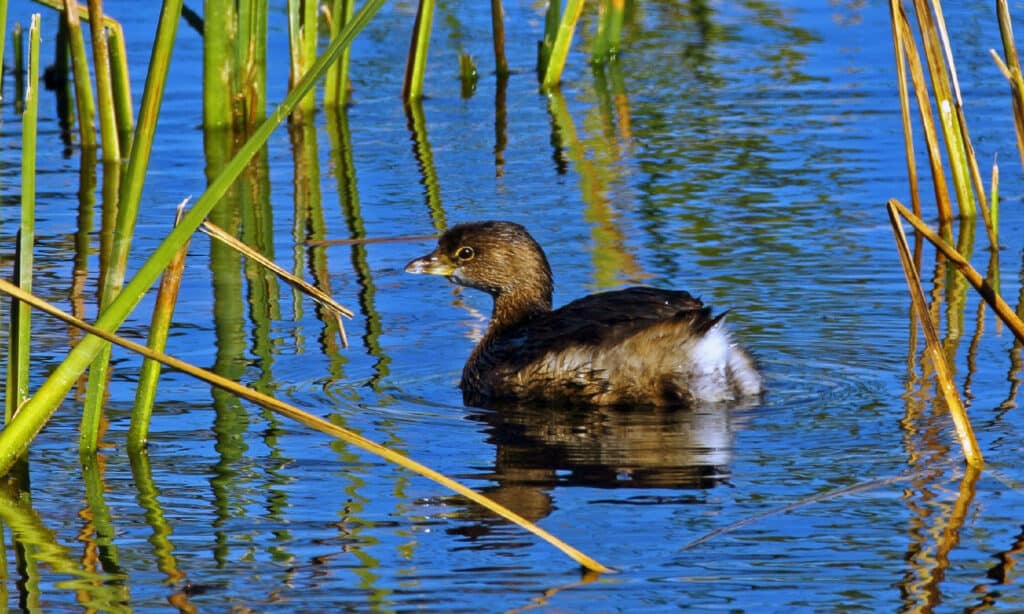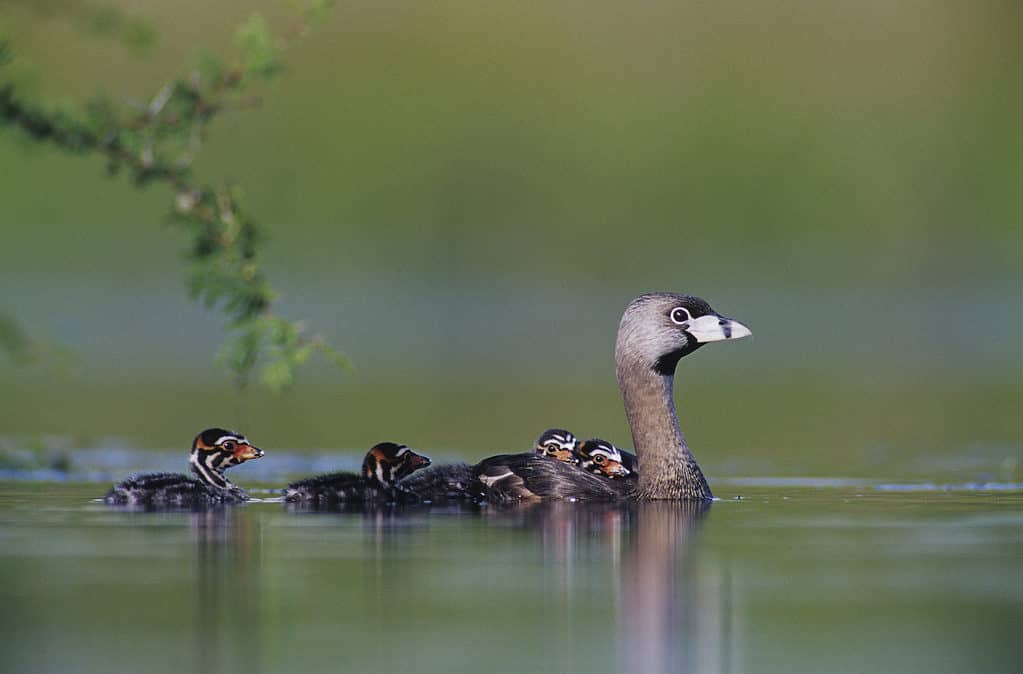Pied-Billed Grebe
Podilymbus podiceps
Chicks stay on the parents' backs until they learn to swim
Advertisement
Pied-Billed Grebe Scientific Classification
- Kingdom
- Animalia
- Phylum
- Chordata
- Class
- Aves
- Order
- Podicipediformes
- Family
- Podicipedidae
- Genus
- Podilymbus
- Scientific Name
- Podilymbus podiceps
Read our Complete Guide to Classification of Animals.
Pied-Billed Grebe Conservation Status
Pied-Billed Grebe Facts
- Prey
- Invertebrates, insects, fish, amphibians, crustaceans
- Main Prey
- Aquatic invertebrates
- Name Of Young
- Chicks
- Group Behavior
- Solitary
- Fun Fact
- Chicks stay on the parents' backs until they learn to swim
- Biggest Threat
- Habitat loss
- Most Distinctive Feature
- Develop a black band on the bill during the summer
- Distinctive Feature
- Lack white feathers under the wings unlike other grebes
- Other Name(s)
- Hell-diver, American dabchick, rail, Carolina grebe, water witch
- Wingspan
- 18-24 inches
- Incubation Period
- 23 days
- Age Of Independence
- 4 weeks
- Habitat
- Freshwater wetlands, marshes, and slow-moving rivers
- Predators
- Owls, rodents, snakes, eagles, falcons
- Diet
- Omnivore
- Number Of Species
- 1
- Location
- Americas
- Migratory
- 1
View all of the Pied-Billed Grebe images!
Summary
Known for their shy and reclusive behavior, pied-billed grebes belong to the grebe family Podicipedidae. These small, stocky water birds live in marshes, wetlands, and rivers throughout the Americas. They aren’t great fliers and frequently dive both to hunt and avoid threats, hence their common name, “hell-diver.” They migrate at night and tend to live alone or in mating pairs instead of flocks.
5 Pied-Billed Grebe Amazing Facts
- When threatened, they may suddenly dive into the water to depths up to 20 feet, which is why people sometimes call them “hell-divers.”
- Pied-billed grebes are closely related to flamingos.
- Due to their lobed (not webbed) feet, pied-billed grebes excel at swimming but struggle to walk on land.
- For the first few weeks of life, their chicks often ride around and sleep on their parents’ backs.
- Pied-billed grebes can trap water in their feathers, which allows them to adjust their buoyancy to sink or rise in water.
Where to Find Pied-Billed Grebes
You can find them throughout much of North and South America, although they are absent from the Amazon and the northernmost parts of Canada. Populations that live in areas where water freezes during the winter will migrate between breeding and non-breeding grounds depending on the season. In North America, migrating populations tend to breed during the summer throughout much of central Canada. They then migrate to winter feeding grounds in the southwestern United States, northwestern Mexico, and southern Latin America. Meanwhile, other populations live year-round in the southern and western United States, central Mexico, the Caribbean, and parts of northern and southern South America. Occasionally, pied-billed grebes may also show up as visitors in the United Kingdom, Hawaii, and the Galapagos Islands.
They primarily make their homes in freshwater habitats such as marshes, wetlands, and slow-moving rivers. They prefer areas with plenty of aquatic vegetation present where they can hide and build their nests. That said, they may also frequent open waters, particularly outside of the breeding season. Additionally, you can sometimes find them in brackish water and made-made waterways.
Pied-Billed Grebe Scientific Name
The pied-billed grebe belongs to the grebe family Podicipedidae, the sole family in the order Podicipediformes. Since the closely related Atitlan grebe went extinct in the late 1980s, pied-billed grebes now represent the sole extant member of the genus Podilymbus. The genus name derives from the Latin word podicipes, meaning “feet at the buttocks,” and the Greek kolymbos, meaning “diver.” Its common name refers to the colors on the short, chicken-like bill. During the winter, the bill looks predominantly silvery-gray, but during the summer, it is encircled by a thick black band. Hence the name “pied-billed,” from the Middle English word pied, short for “magpie,” in reference to its black and white colors, and now generally meaning multi or two-colored.
Pied-Billed Grebe Size, Appearance, and Behavior

Their common name derives from their short, thick bill, which looks silvery-gray in winter and features a black band in the summer during the mating season.
©iStock.com/photographybyJHWilliams
Pied-billed grebes are small, stocky water birds with short necks. On average, they measure 12 to 15 inches long and weigh between 8.9 and 20 ounces. They typically sport a wingspan of 18 to 24 inches long. Females and males appear relatively similar and look primarily brown except for a dark back and crown. Unlike other grebes, they do not possess white features under the wings, although the feathers under the tail are white. Their common name derives from their short, thick bill, which looks silvery-gray in winter and features a black band in the summer during the mating season. Pied-billed grebes possess lobed rather than webbed feet, which aid them with swimming. However, their lobed feet make it difficult for them to walk on land.
Pied-billed grebes rarely fly and typically only do so at night when they migrate. They spend most of their time in the water and are excellent divers. When startled or hunting, they can dive up to 20 feet and stay submerged for up to 30 seconds. They also do not gather in flocks, instead living alone or in mated pairs.
Pied-Billed Grebe Evolution and History
The evolution and history of pied-billed grebes and other grebes continue to challenge researchers to this day. Grebe fossil records are woefully incomplete, which makes it difficult to track their development over time. That said, most scientists believe that grebes have a fairly ancient evolutionary history. While some evidence suggests they may have emerged sometime during the Early or Late Cretaceous Period, more research is needed to prove this theory. True grebes emerged sometime during the Late Oligocene or Early Miocene, around 23 or 25 million years ago. Today, flamingos represent the closest relatives to grebes, as the two share a number of similar characteristics.
Pied-Billed Grebe Diet
Like other grebes, pied-billed grebes are primarily carnivorous. Aquatic invertebrates and insects make up the bulk of their diet, although they also eat small fish, crustaceans, and amphibians, such as frogs. They normally hunt by diving into the water to catch prey, and their strong, sharp bills can break through even the toughest of crustacean shells. While they are primarily carnivorous, they will also eat some aquatic vegetation. In addition, pied-billed grebes have been known to eat their own feathers. This habit likely helps to aid in their digestion and prevent potentially harmful bones and other prey parts from damaging their intestines. The feathers cling to these objects and allow the birds to regurgitate indigestible items as pellets easily.
Pied-Billed Grebe Predators and threats
Several animals prey on pied-billed grebes. Their main predators include birds such as gulls, owls, eagles, falcons, and coots, and fish such as bass and pike. They also must contend with alligators, snapping turtles, and large snakes like cottonmouths. Young grebes and eggs also frequently fall prey to minks, ferrets, rats, and raccoons. To protect themselves, pied-billed grebes will dive into the water to depths up to 20 feet. They can remain underwater for up to 30 seconds until the danger passes. Moreover, their coloration serves as a form of camouflage that allows them to blend into their surroundings to avoid predators easily.
Aside from predators, the major threat to pied-billed grebes comes from human activity. Habitat loss represents possibly the single greatest threat to the pied-billed grebe. When wetlands and marshes dry up or get drained for development, pied-billed grebes lose important breeding and feeding sites. They can also get easily disturbed by noise from boats or cars, which scare them away from their nests. These sounds and other activities can cause the birds to abandon their nests, thereby leaving their eggs vulnerable to damage or predation.
Pied-Billed Grebe Reproduction, Young and Molting

For the first few weeks of life, pied-billed grebe chicks often ride around and sleep on their parents’ backs.
©Danita Delimont/Shutterstock.com
During the summer mating season, pied-billed grebes court each other by using calls and singing duets. A male can act aggressively if another male enters his territory. When this happens, the two males will face off against each other and then turn their backs to issue threatening calls.
Females typically lay between 3 and 10 eggs at a time and can lay two clutches per year. Both parents help to incubate the eggs and will take turns watching the eggs. When neither parent is present, they may cover the eggs with feathers, grass, or other soft material to hide the eggs from predators and keep them warm. The eggs incubate for approximately 23 days until the chicks hatch. Pied-billed grebe chicks cannot swim well when young, so they spend most of their time on their parents’ backs. They may even stay attached when the parents dive for food. After about 4 weeks, they begin to swim and hunt by themselves.
Although pied-billed grebes can live for up to 10 years, most rarely live longer than 4 years.
Pied-Billed Grebe Population
Overall, the pied-billed grebe population appears rather stable. However, populations in certain areas are on the decline for various reasons. For example, some stocks in the eastern half of the United States show signs of distress. Pied-billed grebes have practically disappeared from Rhode Island and are considered endangered in Connecticut and New Hampshire. Although they receive protections under the Migratory Bird Treaty Act of 1918, pied-billed grebes continue to lose breeding and feeding grounds in the densely populated areas of the northeast. Still, these pockets represent the extreme end of the spectrum, and most populations remain in good standing. As a result, the IUCN lists the pied-billed grebe as a species of Least Concern.
Related Animals
View all 192 animals that start with PPied-Billed Grebe FAQs (Frequently Asked Questions)
Are pied-billed grebes carnivores, herbivores, or omnivores?
Pied-billed grebes are primarily carnivorous although they also eat plants and even their own feathers. Their diet consists primarily of aquatic invertebrates as well as some small fish, amphibians, and crustaceans.
Where are pied-billed grebes found?
You can find pied-billed grebes throughout the Americas. You can find certain populations year-round in the western, central, and southern United States, Mexico, and the northern and southern halves of South America. Meanwhile, certain populations breed in the northern and eastern United States and southern Canada and then migrate to the southwestern United States, northern Mexico, and Latin America to feed.
Are pied-billed grebes rare?
Pied-billed grebes are fairly common throughout waterways across the Americas. That said, they may be rare visitors in certain areas depending on the time of year.
What is special about a pied-billed grebe?
Unlike most grebes, pied-billed grebes lack white on their underwings. Also, both sexes look relatively similar, and they rarely make calls during the breeding and mating season.
Thank you for reading! Have some feedback for us? Contact the AZ Animals editorial team.
Sources
- , Available here: https://eol.org/pages/45509028/articles
- , Available here: https://www.audubon.org/field-guide/bird/pied-billed-grebe
- , Available here: https://www.dec.ny.gov/animals/85203.html
- (1970)

















